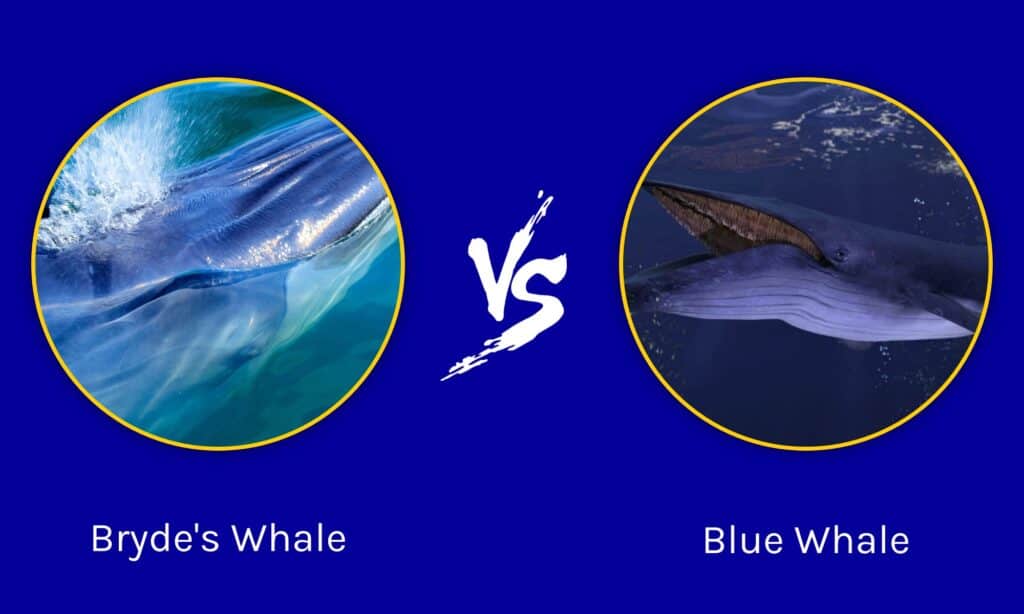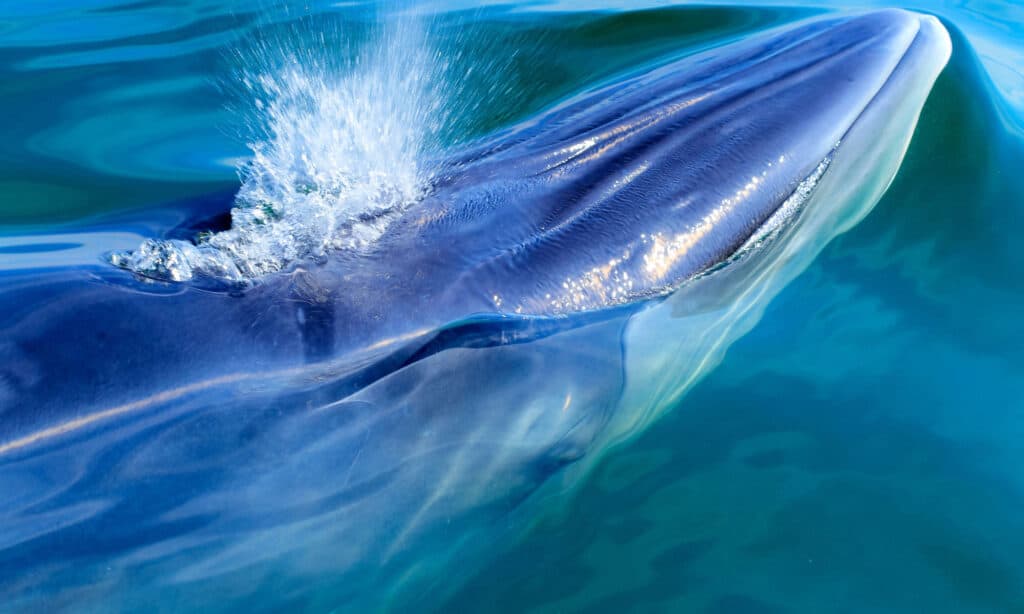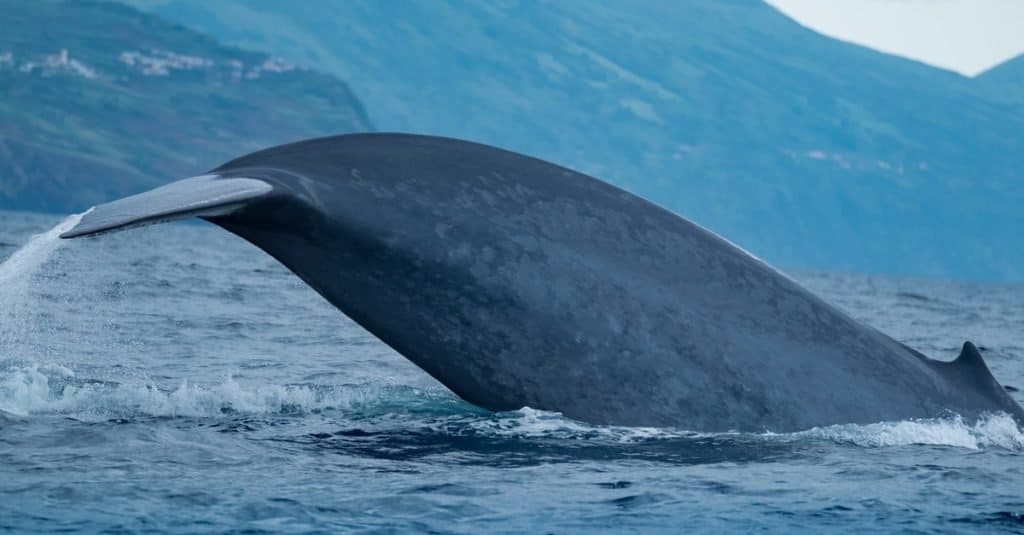Whales are the undisputed largest creatures on earth! Of all the types of whales, baleen whales are the largest. Two types of baleen whales, Bryde’s whales, and blue whales are quite similar and closely related. Still, there are some distinct differences between them. Today, we are going to be taking a closer look at these marine mammals and comparing a Bryde’s Whale vs Blue Whale! Let’s get started.
Comparing a Bryde’s Whale and a Blue Whale

| Bryde’s whale | Blue whale | |
|---|---|---|
| Subspecies and groupings | – Common Bryde’s whale – Eden’s whale | – Northern – Northern Indian Ocean – Pygmy – Antarctic |
| Size | Length: 50 feet long Weight: 12-25 metric tons | Length: Up to 98 feet long Weight: 199 metric tons (438,720 lbs) |
| Appearance | Extremely slender body. Smoky gray coloration on the back with white sides and belly. White patch on the throat. | Long, slender body. Mottled blue-gray body. Broad, flat head. |
| Distribution | The common Bryde’s whale lives in the Atlantic, Pacific, and Indian Oceans between the 40th parallel latitudes. Eden’s whales live around the Gulf of Martaban, Bay of Bengal, Bangladesh, India, Thailand, Vietnam, Taiwan, and China. | Worldwide |
| Population size | 90,00-100,000 individuals. | 10,000-25,000 individuals. |
| Conservation status | Least concern. | Endangered. |
The 6 main differences between a Bryde’s whale and a Blue whale
The main differences between a Bryde’s whale and a blue whale are that Bryde’s whales are smaller, have a larger population, and inhabit a slightly smaller range than the blue whale.
Bryde’s (pronounced Brooder’s) whales and blue whales are both among the largest animals on earth. The Bryde’s whale is often referred to as the Bryde’s whale complex due to the different associated subspecies that are all considered to be Bryde’s whales but haven’t been sufficiently studied. Still, two subspecies are definitively known, the common Bryde’s whale and Eden’s whale. The blue whale is the largest animal to have ever lived on earth and can be broken into four distinct subspecies.
Both Bryde’s and blue whales have similar appearances, although the sheer size of the blue whales makes them quite easy to tell apart. Additionally, Bryde’s whales are usually smoky gray with white sides and bellies, whereas the blue whale appears to be blue across its entirety.
Although Bryde’s whales aren’t well studied, they have a healthy population numbering over 100,000 individuals globally. For comparison, the blue whale has an estimated 10-25,000 individuals globally. Both whales have been targeted by whalers in the past, with the blue whale seeing the most significant decline of the two. Even today, blue whale populations haven’t recovered as well as Bryde’s whales have.
Let’s take a look at some more differences between the two below!
Bryde’s Whale vs Blue Whale: Subspecies and grouping

Bryde’s whales have two distinct subspecies.
©somsak nitimongkolchai/Shutterstock.com
In biology, a complex is a group of organisms that are closely related enough that the distinction between them isn’t always clear. As such, the Bryde’s whale complex encompasses two subspecies, although others have seen been parsed off into their own species group. The two subspecies of Bryde’s whales are the common Bryde’s whale and Eden’s whale. Omura’s whales and Rice’s whales have since been segmented as a different species altogether but were once considered members of the complex.
Blue whales are relatively easy to categorize and have four distinct subspecies. The four blue whale subspecies are the northern subspecies, the northern Indian Ocean subspecies, pygmy blue whales, and the Antarctic subspecies. A group of Chilean blue whales are under consideration and could potentially be classified as a fifth subspecies.
Bryde’s Whale vs Blue Whale: Size

Blue whales are the largest animals to ever exist on earth.
©Andrew Sutton/Shutterstock.com
The common Bryde’s whale is considered to be larger than Eden’s whale. Current data shows that Bryde’s whales can grow up to 50 feet long and weigh up to 12-25 metric tons. These huge mammals are larger than minke whales but smaller than Sei whales.
Although the Bryde’s whale is large, it isn’t too close in size when compared to the blue whale. Blue whales are the largest animals to ever exist on earth. These whales can measure up to 98 feet, although some reports have them surpassing even 100 feet. On top of that, blue whales can weigh nearly 200 metric tons, a number that is hard to comprehend at that scale. A 199 metric ton (nearly half a million pounds) blue whale weighs as many as 175 Hyundai Accents lumped together.
Bryde’s Whale vs Blue Whale: Appearance
Bryde’s whales are extremely slender, even more so than the blue or fin whales. Generally, they are smoky gray in color and have white sides and bellies that aid in camouflage from below. The sei whale, a close relative of Bryde’s whale, is extremely similar in appearance.
Blue whales are a mottled blue-gray color but generally appear solid blue when seen in the water. Like other migrating whales, blue whales are slender but quite a bit thicker when compared to Bryde’s.
Bryde’s Whale vs Blue Whale: Distribution

Blue whales are found nearly everywhere in the ocean.
©Atomic Roderick/Shutterstock.com
The common Bryde’s whale lives in tropical, subtropical, and temperate waters around the world. They generally reside between the 40th parallels of latitude in the Atlantic, Pacific, and Indian Oceans. Eden’s whales have a smaller distribution, generally living in the Indian Ocean and around Southeast Asian waters.
Blue whales are found in nearly every ocean worldwide.
Bryde’s Whale vs Blue Whale: Population size

Blue whales only have 10-25,000 individuals remaining.
©Wild_and_free_naturephoto/Shutterstock.com
The population of the Bryde’s whale is stable. Global estimates show that there are likely 90,00-100,000 individuals, including both subspecies.
Blue whales have a much smaller population due to whaling practices in the 20th century. Current estimates place the global blue whale population between 10,000-25,000 individuals. Before industrialized whaling, the global population was likely between 300-350,000 individuals.
Bryde’s Whale vs Blue Whale: Conservation status
Both species of Bryde’s whale are listed as Least Concern by the IUCN. The New Zealand Bryde’s whale, however, is considered critically endangered, with only 200 individuals remaining.
Blue whales are listed as Endangered by the IUCN. They are still under threat, primarily from boat strikes, pollution, and climate change.
Thank you for reading! Have some feedback for us? Contact the AZ Animals editorial team.








